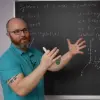

NARROW DISPLAY WARNING
You are most likely using a tablet or mobile device in portrait orientation. This website is best viewed using a typical computer screen with the browser window maximized.
Viewing this website in portrait orientation can cause problems with equations being longer than the screen width (you can scroll to the right), images being poorly sized, and the font size of maths text being much smaller than regular text. If your only option is a tablet or mobile device, your viewing experience will be better if you view this website in landscape orientation. You might need to refresh the page to fix any problems after rotating.
Sometimes a differential equation is not exact but can be made exact by multiplying by an integrating factor, usually called $\mu(x,y)$. Unlike the method of integrating factor in a first order linear ODEs, a major difficulty in finding an integrating factor to an inexact equations is solving an even more difficult partial differential equation. However, it's easier if we can find an integrating factor that is only a function of $x$ or only a function of $y$, but not both.
Let's assume the following differential equation is not an exact equation.
$\displaystyle M(x,y) + N(x,y)y' = 0 \qquad\qquad \frac{\partial }{\partial x}N \neq \frac{\partial }{\partial y}M \qquad$ since we said the equation is not exact.
Multiply by an unknown function $\mu(x,y)$ to make the equation exact.
\begin{equation} \mu(x,y)M(x,y) + \mu(x,y)N(x,y)y' = 0 \end{equation}For the equation to be exact, the same test must work with the partial derivatives of the $y'$ term and the term without $y'$.
\begin{equation} \frac{\partial }{\partial x}\Big(\mu(x,y)N(x,y)\Big) = \frac{\partial }{\partial y}\Big(\mu(x,y)M(x,y)\Big) \end{equation}Using the product rule with the partial derivatives creates an even more difficult to solve partial differential equation.
\begin{equation} \left(\frac{\partial }{\partial x}\mu(x,y)\right)N(x,y) + \mu(x,y)\left(\frac{\partial }{\partial x}N(x,y)\right) = \left(\frac{\partial }{\partial y}\mu(x,y)\right)M(x,y) + \mu(x,y)\left(\frac{\partial }{\partial y}M(x,y)\right) \end{equation} \begin{equation} \frac{\partial \mu}{\partial x}N + \mu\frac{\partial N}{\partial x} = \frac{\partial \mu}{\partial y}M + \mu\frac{\partial M}{\partial y} \end{equation}This is no easy way to find a solution to this partial differential equation, but sometimes the integrating factor is only a function of one variable instead of both variables. The equation become much simpler if we try $\mu(x,y)=\mu(x)$ as just a function of $x$ because $\displaystyle \frac{\partial \mu}{\partial y} = 0$ and solving for $\mu(x)$ is a differential equation of one variable instead of two variables. Rearranging gives a nice equation for $\mu$ and $\dfrac{\partial \mu}{\partial x} = \mu'(x)$.
\begin{equation} \mu(x,y)=\mu(x) \Rightarrow \frac{\partial \mu}{\partial y} = 0 \qquad\qquad \frac{\partial \mu}{\partial x}N + \mu\frac{\partial N}{\partial x} = 0M + \mu\frac{\partial M}{\partial y} \end{equation}$\displaystyle \frac{\mu'(x)}{\mu(x)} = \frac{\dfrac{\partial M}{\partial y}-\dfrac{\partial N}{\partial x}}{N} \qquad$ which must simplify to a function of $x$.
There's a similar equation when assuming $\mu(x,y)=\mu(y)$ with $\displaystyle \frac{\partial \mu}{\partial x} = 0$ and $\dfrac{\partial \mu}{\partial y} = \mu'(y).$
$\displaystyle \frac{\mu'(y)}{\mu(y)} = \frac{\dfrac{\partial N}{\partial x}-\dfrac{\partial M}{\partial y}}{M} \qquad$ which must simplify to a function of $y$.
However, sometimes there is no integrating factor that is function of just one of the variables, in which case finding the integrating factor becomes difficult to impossible.
Find an integrating factor for the inexact equation and solve the resulting exact equation.
\begin{equation} 3y + \frac{y^{2}}{x} + (x+y)y' = 0 \end{equation}Find an integrating factor for the inexact equation and solve the resulting exact equation.
\begin{equation} 2xy^{3} + (3x^{2}y^{2} + x^{2}y^{3} + 1)y' = 0 \end{equation}Determine $a$ and $b$ in $\mu(x,y)=x^{a}y^{b}$ for an integrating factor.
\begin{equation} -y + (x+x^{6})y' = 0 \qquad\qquad \mu(x,y) = x^{a}y^{b} \end{equation}